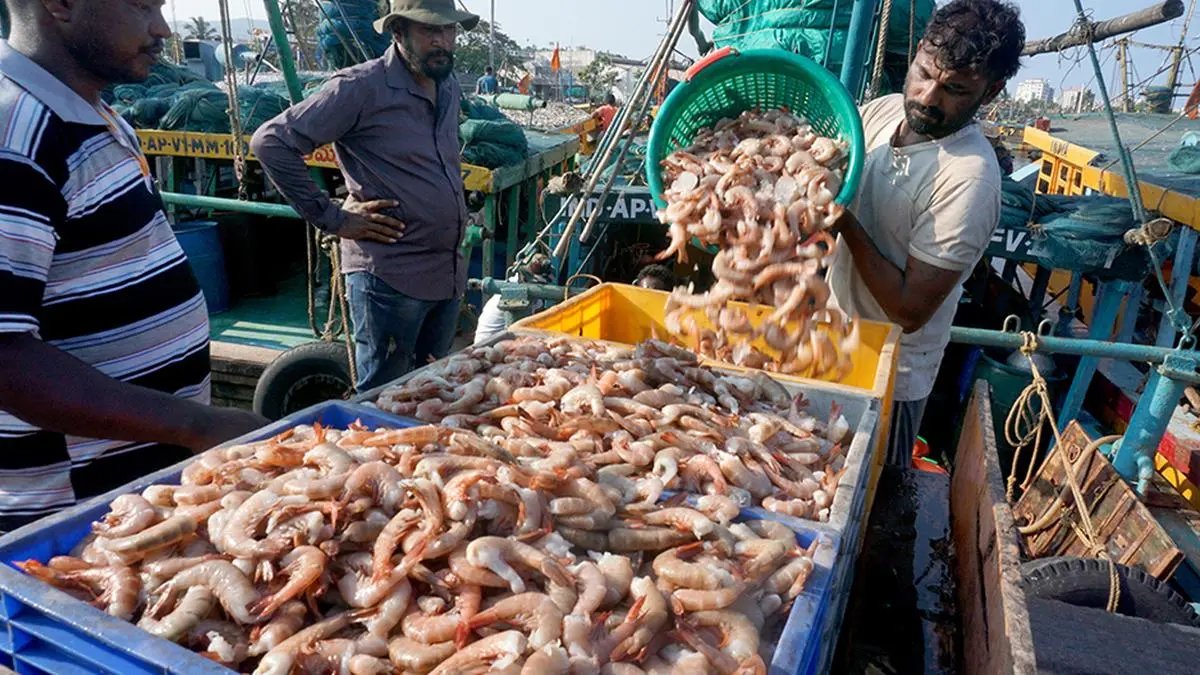Ripple effects of tariffs: How US duties on Indian seafood expose the fragility of global trade


The notion that the US can easily substitute Indian seafood with imports from other countries like Ecuador, Thailand, Indonesia or Vietnam is misleading.
| Photo Credit:
C.V.Subrahmanyam
The imposition of a 50 per cent tariff by the US on Indian seafood exports, particularly shrimp, has laid bare the fragile complexities of global trade. While on the surface, diversifying export markets to regions such as the European Union, Japan and South-East Asia sounds like a straightforward solution, the reality is far more complicated.
Diversification efforts are met with significant regulatory and logistical challenges. The European Union, for example, accounts for a substantial share of India’s seafood exports and enforces stringent microbial, traceability, and sustainability standards that surpass those of the US. Meeting these strict requirements demands costly certifications, rigorous testing, and compliance protocols that vary based on climatic conditions and political relations. Japan and other Asian markets also maintain high barriers to entry. These regulatory complexities, coupled with seasonal and geographic factors, create a patchwork of challenges for exporters.
The effects of these hurdles are visible on the ground. Industry experts estimate a decline of 15-18 per cent in Indian shrimp export volumes in 2025, with a marked drop in recent months resulting in domestic price falls as unsold inventory builds up. While India is actively seeking approvals and trade agreements to ease some of these barriers, such measures require considerable time and investment before they can substantially replace lost US demand.
Misleading notion
On the flip side, the notion that the US can easily substitute Indian seafood with imports from other countries like Ecuador, Thailand, Indonesia or Vietnam is misleading. Though Ecuador has increased its presence in the US market, the majority of its shrimp exports still go to China, where trade relationships and market guarantees remain more secure, even if margins are thin. Ecuador and other potential suppliers face their own climate, social and logistical constraints that limit rapid expansion of supply to the US.
India, which supplied roughly 35 to 40 per cent of US shrimp imports before the tariffs, cannot be quickly replaced. Ecuador holds about 14 to 17 per cent, Indonesia 17 per cent and Vietnam 8 to 9 per cent of the US shrimp market. This distribution makes it unrealistic for these countries alone to absorb the volume lost from India, especially since they also face tariffs in the US ranging from 10 to 20 per cent. This layered tariff structure and supply-side limitations ensure that short-term substitution is far from seamless.
As for major US retailers such as Walmart and Costco, their response has been a balancing act between maintaining supply and managing cost increases. Both companies have longstanding relationships with Indian shrimp exporters and are currently negotiating pricing concessions while absorbing part of the tariff cost themselves. However, this cost-sharing cannot continue indefinitely without affecting retail prices or reducing purchase volumes. Indian shrimp exports to the US have already fallen as much as 50 per cent in some categories since the tariff implementation, and estimates point to potential losses close to $3 billion in revenue for Indian exporters if the situation persists.
More than simple market economics
The situation underscores that trade flows are shaped by much more than simple market economics. Climate, regulatory frameworks, lengthy supply relationships and geopolitical factors deeply influence the viability of supply chains. Disruptions like these tariffs reveal the vulnerabilities of globally integrated seafood markets and the challenges in building resilience amid shifting political landscapes.
Ultimately, while India aspires to diversify its seafood export destinations, the process involves navigating complex regulatory landscapes, climatic realities and entrenched global trade dynamics. Simultaneously, the US market’s dependence on Indian shrimp cannot easily be replaced by other suppliers without significant cost, supply and time penalties. This episode is a vivid reminder that in today’s interconnected world, trade disruptions can subtly ripple through industries, economies and communities across continents.
The author is National Legal Advisor, Soluble Fertilizer Industry Association (SFIA)
Published on October 11, 2025


